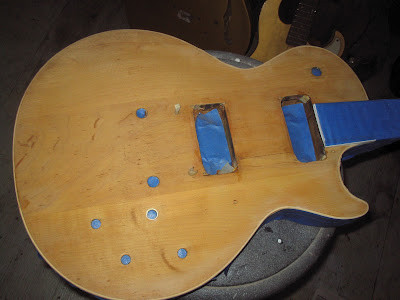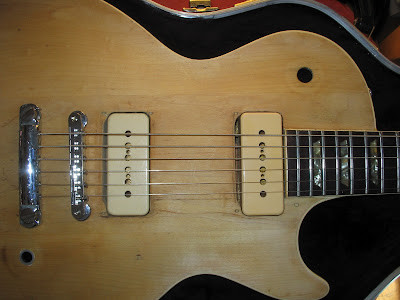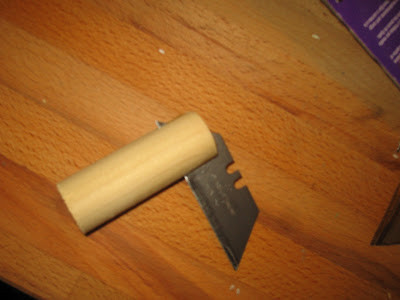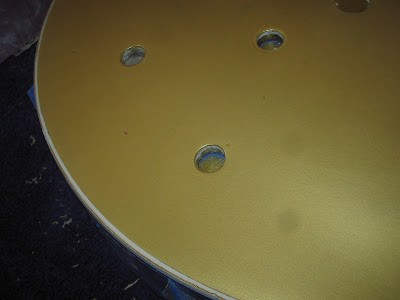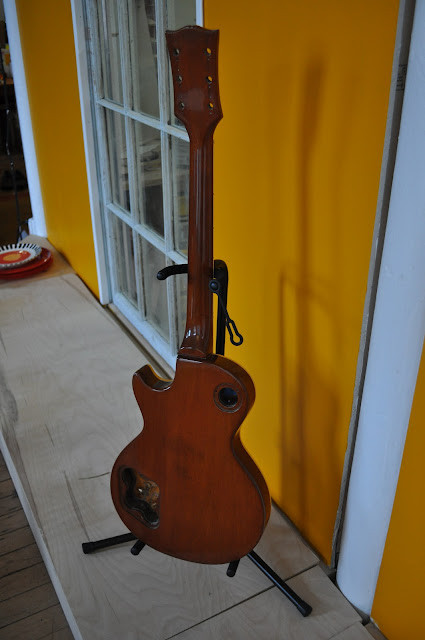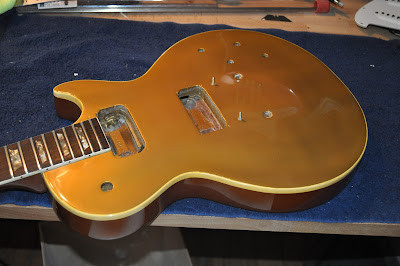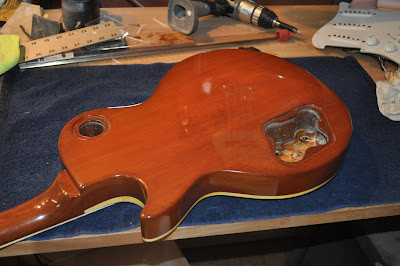The Gibson Les Paul Gold Top finish. Just the name evokes images of legendary guitarists and iconic riffs. Since its introduction in the early 1950s, this shimmering, metallic gold finish has become one of the most recognizable and sought-after aesthetics in the world of electric guitars. Originally gracing the Les Paul Model and the ES-295, the Gold Top finish wasn’t just about looks; it represented a bold step forward in guitar design and a commitment to visual excellence.
This article delves into the captivating world of the Les Paul Gold Top finish, taking you through the intricate process of refinishing a vintage guitar to recapture this classic beauty. We’ll explore the unique composition of this finish, the challenges it presents, and the meticulous steps involved in achieving a stunning, authentic Gold Top result. Whether you’re a seasoned luthier or a passionate guitar enthusiast, understanding and appreciating the Gold Top finish is essential for anyone drawn to the timeless appeal of the Les Paul guitar.
Unveiling the Gold Top Magic: Materials and Methods
The secret to the mesmerizing Gold Top finish lies in its unique composition. Unlike standard paint finishes, the Gold Top achieves its metallic sheen by suspending finely ground bronze powder within a clear lacquer. This isn’t just any gold paint; it’s a carefully crafted mixture where the bronze particles interact with light to create a deep, lustrous metallic gold that shifts and shimmers with movement.
However, this beauty comes with a challenge. The very nature of bronze powder makes it a difficult material to work with. Achieving an even color distribution and consistent results requires skill, patience, and a deep understanding of the application process. The bronze particles tend to settle and clump, demanding constant stirring and precise spray techniques to avoid uneven patches or blotches in the finish. This inherent difficulty is part of what makes a well-executed Gold Top refinish so impressive and valuable.
The guitar featured in this process is a 1969 Les Paul Deluxe Standard. This particular model is significant as one of Gibson’s early attempts at “re-issuing” the coveted 1950s Les Pauls. Originally, these guitars sported P-90 pickups and, of course, the iconic Gold Top finish, complemented by a stained mahogany back and neck and elegant white binding on both the top and neck. The example at hand had undergone some modifications and stripping, including routing for humbucker pickups and some prior refinishing work on the back and neck.
Close up view of a 1969 Les Paul Deluxe Standard guitar body showing widened pickup cavities prepared for humbucker installation.
While considering returning the guitar to its original P-90 configuration was discussed, the owner’s preference for the richer sound of humbuckers ultimately prevailed. As seen in the image, the pickup cavities had been previously enlarged to accommodate these pickups, a modification that would be retained in the refinishing process.
Matching the Legacy: Bronze Powder and Color Tinting
One crucial step in achieving an authentic Gold Top finish is sourcing the correct bronze powder. In a quest for historical accuracy, the owner of this Les Paul tracked down the original supplier used by Gibson in the 1950s: Crescent Bronze Co. of Oshkosh, WI. They procured “Extra Brilliant Gold #256” Cres-Lite bronze powder, the very same type that contributed to the legendary sheen of vintage Gold Tops. Crescent Bronze offers a wide array of metallic pigments, a treasure trove for anyone seeking to recreate or explore metallic finishes.
Remnants of the original gold finish visible within the pickup cavities of the Les Paul, serving as a color reference.
Interestingly, modern Gibson Gold Top finishes have shifted away from bronze powder. They now utilize mica chips coated with a gold-colored pigment. This change was implemented to address the “greening” phenomenon that classic Gold Tops often exhibit over time. This greening is a result of the copper content in the bronze powder oxidizing when the protective clear coat wears away, typically near the forearm contour where skin contact and sweat accelerate the process.
Close up of Cres-Lite Extra Brilliant Gold #256 bronze powder, the key ingredient for an authentic Les Paul Gold Top finish.
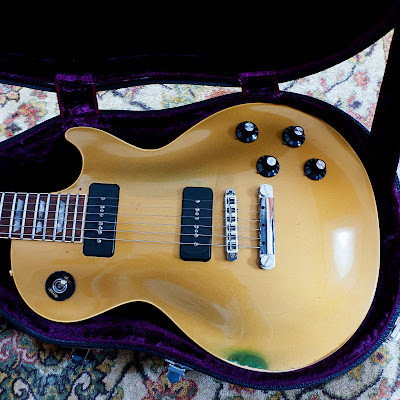 |
|---|
| Example of the characteristic “greening” effect on a vintage Les Paul Gold Top finish due to oxidation. |
Step-by-Step to Gold: The Refinishing Process
Achieving a flawless Gold Top finish requires meticulous preparation and execution. Here’s a breakdown of the key steps:
-
Surface Preparation: The initial stage involves addressing any imperfections in the guitar’s top. Small dings and dents are filled, and the maple top is meticulously sealed and sanded to an incredibly smooth and even surface. This level of smoothness is paramount because, as with any metallic finish, any flaw beneath the surface will be magnified by the reflective nature of the gold. For close-grained woods like maple, a nitrocellulose sanding sealer is ideal, eliminating the need for a separate grain filler. Importantly, Gibson’s traditional lacquer finishes, including the Gold Top, do not utilize a primer coat.
-
Binding Preparation: Before applying the gold color coat, the sides of the guitar binding are carefully masked off. However, the top edge of the binding is intentionally left unmasked. Gibson’s traditional method involves spraying the color coat directly over the binding and then “scraping” the excess paint off with a razor blade once the finish is partially cured. This technique is considered more precise and cleaner than attempting to mask the complex curves of the binding along the guitar top. Masking the straight sides is straightforward, offering a clean edge for the gold finish.
-
Mixing and Spraying the Gold Top Color: The gold color is mixed by carefully combining bronze powder with clear gloss lacquer. A ratio of approximately two teaspoons of bronze powder to six ounces of lacquer is a good starting point. This mixture is then thinned, often around 50%, for optimal spraying consistency. Crucially, constant stirring of the mixture during spraying is essential to prevent the bronze powder from settling and causing uneven application.
-
Spraying Technique and Avoiding Pitfalls: Applying the Gold Top finish is where technique truly matters. Multiple thin coats are preferable to a single heavy coat, allowing for better control and even distribution of the bronze particles. A critical lesson learned during this refinishing process was the importance of gun maintenance. Metallic pigments like bronze powder can easily clog spray guns. Immediate and thorough cleaning of the spray gun after applying the gold coat is vital. Furthermore, it’s strongly recommended to dedicate separate spray guns for metallic finishes and clear coats to prevent cross-contamination. Even minute traces of metallic pigment can ruin a pristine clear coat on a subsequent project.
Freshly sprayed Les Paul Gold Top finish, showcasing the even metallic sheen achieved through careful application.
- Binding Scraping: Once the gold color coat has sufficiently set, the process of scraping the paint off the binding begins. Specialized tools, like a jig crafted from a dowel and a razor blade, can aid in achieving a clean, consistent scraped edge. However, some freehand scraping might also be necessary for intricate areas. The key is to apply gentle pressure, as the lacquer is softer than the binding when not fully cured. The goal is to remove the gold finish from the binding’s top edge without gouging or damaging the plastic itself. Ideally, the sealer coat acts as a buffer between the binding and the gold top, preventing the gold finish from deeply embedding into the binding.
Close up demonstrating the binding scraping process, removing excess gold finish from the edge of the guitar binding.
The guitar binding after scraping, revealing the clean white edge contrasting with the gold top.
Close up showing the top edge of the guitar binding fully scraped and cleaned, ready for clear coating.
- Tinted Clear Coat and Final Finish: To achieve the subtle aged tint characteristic of vintage Gold Tops and to blend the binding seamlessly with the overall finish, a tinted clear coat is applied. A vintage amber tint, like Stew-Mac’s, mixed into a clear gloss base, is ideal. The tint is built up gradually through several thin coats, carefully monitoring the color against reference points like the original finish remnants in the pickup cavities. This tinted clear coat not only ages the gold but also imparts a subtle warmth to the white binding, creating a cohesive vintage aesthetic. Finally, the entire instrument, including the previously unfinished back and neck, receives multiple clear coats to ensure durability and depth.
The Les Paul body after tinted clear coating, showing the aged hue of the gold top and binding.
- Wet Sanding and Buffing: After allowing ample curing time for the clear coat (several weeks is recommended), the final stages of wet sanding and buffing commence. This process levels the clear coat to a glass-like smoothness and brings out the full luster of the Gold Top finish. Due to the carved top of a Les Paul and the presence of fixed bridge posts, hand wet sanding is often necessary for the top. Extra care must be taken during sanding to avoid cutting through the clear coat, especially on the edges and contours.
The Reborn Gold Top: A Testament to Craftsmanship
The result of this meticulous refinishing journey is a Les Paul reborn, radiating the classic elegance of a Gold Top. The shimmering gold finish, paired with the subtly aged binding and clear coat, captures the vintage vibe perfectly. Even details like preserving the original headstock finish contribute to the guitar’s character and story.
Final view of the refinished Les Paul Gold Top guitar, showcasing the restored luster and vintage-accurate finish.
Refinishing a Les Paul Gold Top is undoubtedly a labor-intensive and challenging undertaking. However, for those passionate about vintage guitars and the iconic Gold Top aesthetic, the reward is a beautifully restored instrument that embodies a piece of guitar history. The gleaming Gold Top finish is more than just a color; it’s a symbol of Gibson’s legacy and the enduring appeal of the Les Paul.


